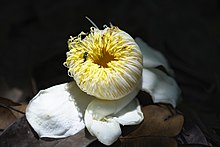Lecythis ollaria
Lecythis ollaria is a species of tree found growing in forests in Brazil and Venezuela. The tree is known locally as coco de mono, and accumulates selenium in its tissues.
| Lecythis ollaria | |
|---|---|
 | |
| Scientific classification | |
| Kingdom: | Plantae |
| Clade: | Tracheophytes |
| Clade: | Angiosperms |
| Clade: | Eudicots |
| Clade: | Asterids |
| Order: | Ericales |
| Family: | Lecythidaceae |
| Genus: | Lecythis |
| Species: | L. ollaria |
| Binomial name | |
| Lecythis ollaria | |
Description
The paradise nut is a large tree with spreading branches. It is in the same family as the Brazil nut tree (Bertholletia excelsa) and has a similar fruit. This is a large woody capsule with a lid which bursts open when the seeds are ripe. Monkeys are said to put their hands inside the capsule in order to extract the seeds which have a fleshy interior rich in oil and a woody outer casing.[2]
Toxicity
The nuts have a pleasant flavour and are eaten by humans.[2] When two previously healthy women in South America developed unexplained nausea, vomiting and neurological symptoms, followed two weeks later by heavy hair loss, no cause could at first be found. It was later established that they were suffering from acute selenium toxicity brought on by eating paradise nuts. They still had elevated levels of selenium in their blood eight weeks after they had eaten the nuts.[3] Further investigation of the tree found that the tissues of the bark, leaves, capsules and seeds all contained selenium but that the highest concentration was in the nuts which contained about five grams per kilogram, about half of which was soluble in water.[4] The tree is considered to be a selenium accumulator and part of the element is bound to very selenium-rich proteins.[5]
Status
The IUCN Red List of Threatened Species lists the paradise nut as being of least concern. This is because it has a widespread geographical distribution in the tropical rainforest.[1]
References
- Pires O'Brien, J. (1998). "Lecythis ollaria". IUCN Red List of Threatened Species. 1998. Retrieved 2012-08-27.
- Armstrong, W. P. "Brazil, Paradise & Cashew Nuts". Wayne's Word. Retrieved 2012-08-27.
- Müller, D; Desel, H. (2010). "Acute selenium poisoning by paradise nuts (Lecythis ollaria)". Human and Experimental Toxicology. 29 (5): 231–234. doi:10.1177/0960327109360046. PMID 20106940.
- Ferri, T.; Coccioli, F.; De Luca, C.; Callegari, C. V.; Morabito, R. (2004). "Distribution and speciation of selenium in Lecythis ollaria plant". Microchemical Journal. 78 (2): 195–203. doi:10.1016/j.microc.2004.06.001.
- Hammel, C.; Kyriakopoulos, A.; Behne, D.; Gawlik, D.; Brätter, V. (1996). "Protein-bound selenium in the seeds of coco de mono (Lecythis ollaria)". Journal of Trace Elements in Medicine and Biology. 10 (2): 96–102. doi:10.1016/S0946-672X(96)80017-4. PMID 8829132.
